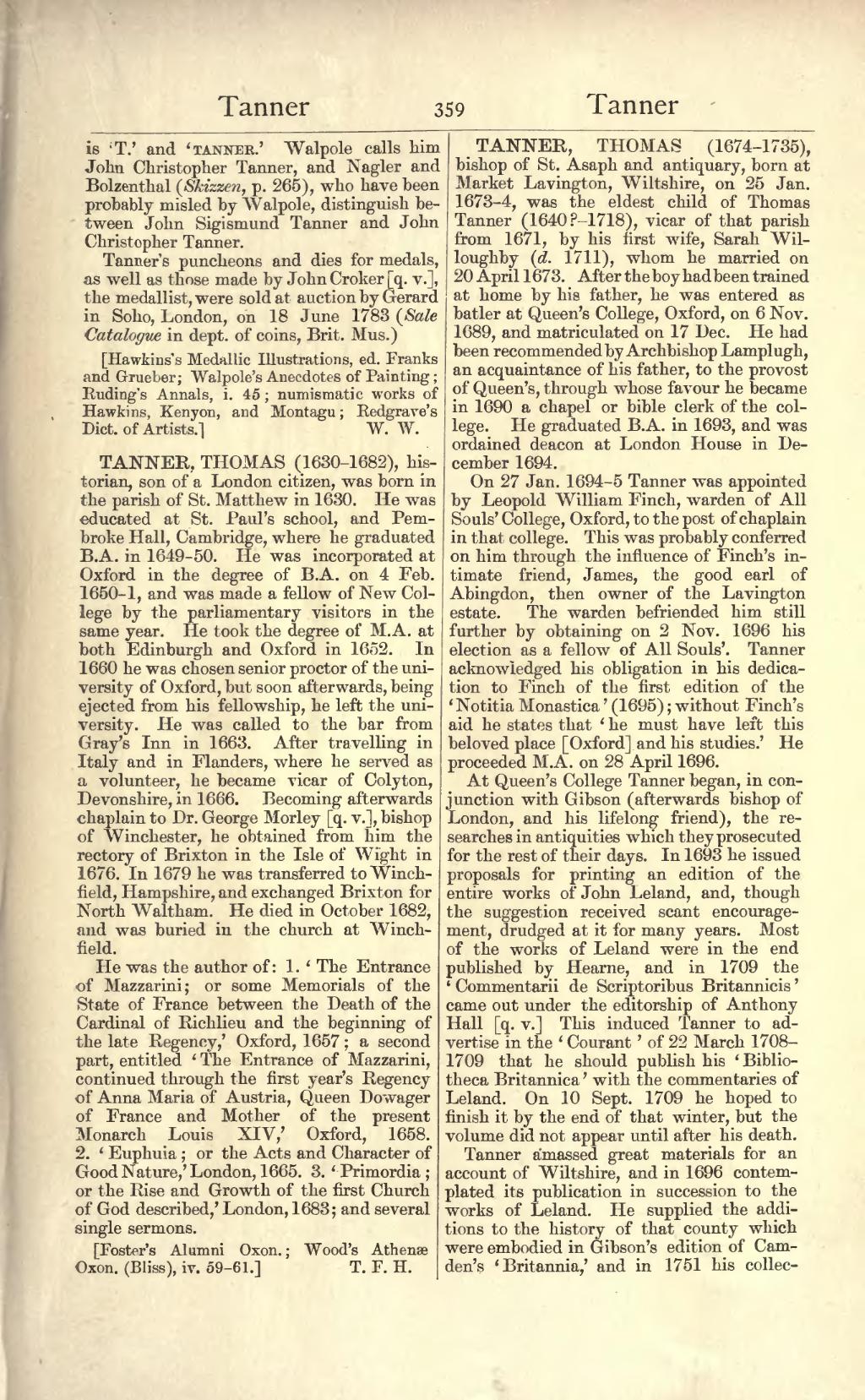is ‘T.’ and ‘Tanner.’ Walpole calls him John Christopher Tanner, and Nagler and Bolzenthal (Skizzen, p. 265), who have been probably misled by Walpole, distinguish between John Sigismund Tanner and John Christopher Tanner.
Tanner's puncheons and dies for medals, as well as those made by John Croker [q. v.], the medallist, were sold at auction by Gerard in Soho, London, on 18 June 1783 (Sale Catalogue in dept. of coins, Brit. Mus.)
[Hawkins's Medallic Illustrations, ed. Franks and Grueber; Walpole's Anecdotes of Painting; Ruding's Annals, i. 45; numismatic works of Hawkins, Kenyon, and Montagu; Redgrave's Dict. of Artists.]
TANNER, THOMAS (1630–1682), historian, son of a London citizen, was born in the parish of St. Matthew in 1630. He was educated at St. Paul's school, and Pembroke Hall, Cambridge, where he graduated B.A. in 1649–50. He was incorporated at Oxford in the degree of B.A. on 4 Feb. 1650–1, and was made a fellow of New College by the parliamentary visitors in the same year. He took the degree of M.A. at both Edinburgh and Oxford in 1652. In 1660 he was chosen senior proctor of the university of Oxford, but soon afterwards, being ejected from his fellowship, he left the university. He was called to the bar from Gray's Inn in 1663. After travelling in Italy and in Flanders, where he served as a volunteer, he became vicar of Colyton, Devonshire, in 1666. Becoming afterwards chaplain to Dr. George Morley [q. v.], bishop of Winchester, he obtained from him the rectory of Brixton in the Isle of Wight in 1676. In 1679 he was transferred to Winchfield, Hampshire, and exchanged Brixton for North Waltham. He died in October 1682, and was buried in the church at Winchfield.
He was the author of: 1. ‘The Entrance of Mazzarini; or some Memorials of the State of France between the Death of the Cardinal of Richlieu and the beginning of the late Regency,’ Oxford, 1657; a second part, entitled ‘The Entrance of Mazzarini, continued through the first year's Regency of Anna Maria of Austria, Queen Dowager of France and Mother of the present Monarch Louis XIV,’ Oxford, 1658. 2. ‘Euphuia; or the Acts and Character of Good Nature,’ London, 1665. 3. ‘Primordia; or the Rise and Growth of the first Church of God described,’ London, 1683; and several single sermons.
[Foster's Alumni Oxon.; Wood's Athenæ Oxon. (Bliss), iv. 59–61.]
TANNER, THOMAS (1674–1735), bishop of St. Asaph and antiquary, born at Market Lavington, Wiltshire, on 25 Jan. 1673–4, was the eldest child of Thomas Tanner (1640?–1718), vicar of that parish from 1671, by his first wife, Sarah Willoughby (d. 1711), whom he married on 20 April 1673. After the boy had been trained at home by his father, he was entered as batler at Queen's College, Oxford, on 6 Nov. 1689, and matriculated on 17 Dec. He had been recommended by Archbishop Lamplugh, an acquaintance of his father, to the provost of Queen's, through whose favour he became in 1690 a chapel or bible clerk of the college. He graduated B.A. in 1693, and was ordained deacon at London House in December 1694.
On 27 Jan. 1694–5 Tanner was appointed by Leopold William Finch, warden of All Souls' College, Oxford, to the post of chaplain in that college. This was probably conferred on him through the influence of Finch's intimate friend, James, the good earl of Abingdon, then owner of the Lavington estate. The warden befriended him still further by obtaining on 2 Nov. 1696 his election as a fellow of All Souls'. Tanner acknowledged his obligation in his dedication to Finch of the first edition of the ‘Notitia Monastica’ (1695); without Finch's aid he states that ‘he must have left this beloved place [Oxford] and his studies.’ He proceeded M.A. on 28 April 1696.
At Queen's College Tanner began, in conjunction with Gibson (afterwards bishop of London, and his lifelong friend), the researches in antiquities which they prosecuted for the rest of their days. In 1693 he issued proposals for printing an edition of the entire works of John Leland, and, though the suggestion received scant encouragement, drudged at it for many years. Most of the works of Leland were in the end published by Hearne, and in 1709 the ‘Commentarii de Scriptoribus Britannicis’ came out under the editorship of Anthony Hall [q. v.] This induced Tanner to advertise in the ‘Courant’ of 22 March 1708–1709 that he should publish his ‘Bibliotheca Britannica’ with the commentaries of Leland. On 10 Sept. 1709 he hoped to finish it by the end of that winter, but the volume did not appear until after his death.
Tanner amassed great materials for an account of Wiltshire, and in 1696 contemplated its publication in succession to the works of Leland. He supplied the additions to the history of that county which were embodied in Gibson's edition of Camden's ‘Britannia,’ and in 1751 his collec-
